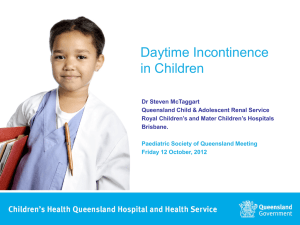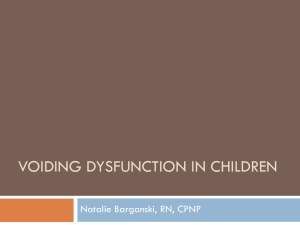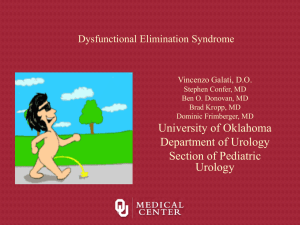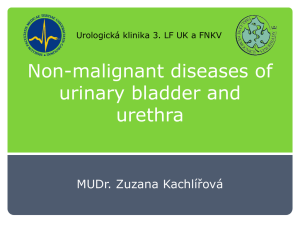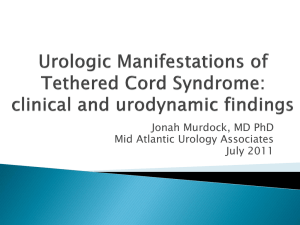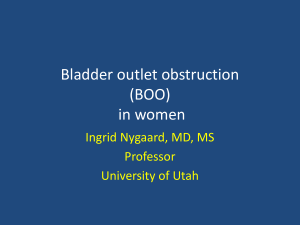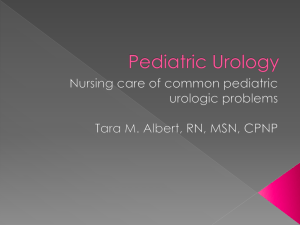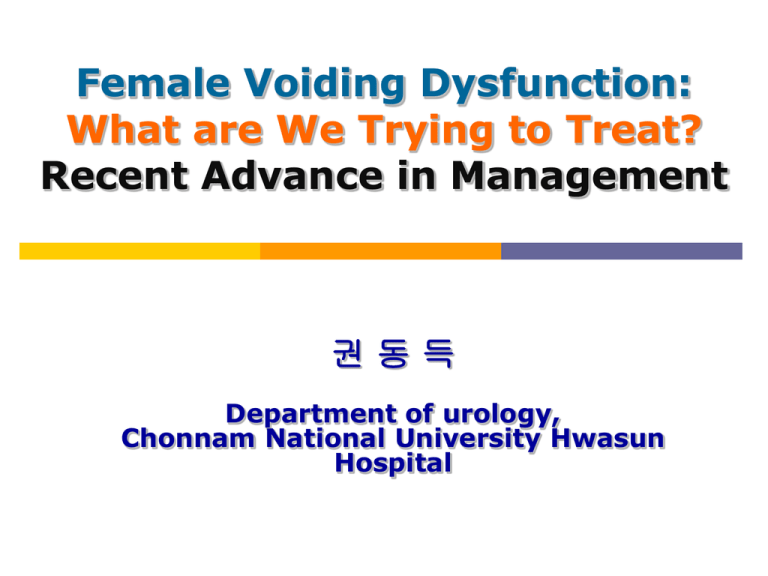
Female Voiding Dysfunction:
What are We Trying to Treat?
Recent Advance in Management
권동득
Department of urology,
Chonnam National University Hwasun
Hospital
What’s the female voiding
dysfuction?
Female voiding dysfunction is
complex in nature
poorly understood,
lacks standard definition
no consensus on diagnostic criteria
difficult to treat
Majority of women
– neurologically intact but cause is idiopathic
It’s common & affect QoL
but paucity of literature on its management
CHONNAM
NATIONAL
UNIVERSITY
HOSPITAL
Female voiding dysfunction
No agreed classification specific to female voiding
dysfunction
ICS definition of voiding dysfunction
“A complex of symptoms represented by
abnormalities of sensation related to voiding”
Focusing on bladder and urethral activity during
voding
Bladder: detrusor underactivity, acontractile bladder
Urethra: bladder outlet obstruction, intermittent involuntary contraction
of periurethral muscle during voiding, detrusor sphinter dyssynergia,
non-relaxing urethral sphincter obstruction
Abrams et al. Neurourol Urodyn 2002;21:119-167
CHONNAM
NATIONAL
UNIVERSITY
HOSPITAL
Prevalence of LUTS and
associated bother in women
Coyne KS et al. BJUI 2009;104:352-360
CHONNAM
NATIONAL
UNIVERSITY
HOSPITAL
Overlap of storage, voiding
and postmicturition symptoms
EpiLUTS
survey
15861
women
75%
women
reported at
least one
LUTS
Sexton CC et al. BJUI 2009;103:3:S12-S23
CHONNAM
NATIONAL
UNIVERSITY
HOSPITAL
Overlap of storage, voiding
and postmicturition symptoms
Sexton CC et al. BJUI 2009;103:3:S12-S23
CHONNAM
NATIONAL
UNIVERSITY
HOSPITAL
Classification of voiding
difficulties & retention
Monga AK. Textbook of urogynecology 2001, pp. 855-863.
Condition
Symptoms
Urodynamic data
Asymptomatic VD
Frequency UTI
Reduced flow, elevateated,
normal or reduced voiding
pressure with or without
residual urine
Symptomatic VD
Reduced stream, incomplete
emptying, straining,
frequency, UTI
Peak flow <15ml/s, elevated
voiding pressure with or
without residual urine
Acute retention
Painful or painless
Residual urine
Chronic retention
Reduced sensation, poor
stream, incomplete emptying,
straining, frequency, nocturia,
incontinence, UTI
Flow<15ml/s Low or elevated
voiding pressure, residual
urine with or without upper
tract dilatation
CHONNAM
NATIONAL
UNIVERSITY
HOSPITAL
Etiological factors
Idiopathic
Most common cause, may be consequence of ageing
Urethral cause
BOO intrinsic or extrinsic, Neurogenic bladder by detrusor sphincter
dyssynergia, Intrinsic urethral stricture, urethral diverticulum, genital prolapse,
Fowler’s syndrome, Hinman syndrome
Bladder cause
Overdistension, hypocontractile or acontractile bladder, detrusor myopathy
Iatrogenic cause
Anti-incontinence surgery (TVT, TOP), Pelvic surgery, Genital trauma, childbirth
Neurogenic cause
DSD, non-relaxing urethral sphincter obstruction
CHONNAM
NATIONAL
UNIVERSITY
HOSPITAL
Etiological factors
Pharmacologic cause
Anticholinergics and ganglion blocking agents, adrenergic agonist
(duloxetine), anti-psychotics, anti-parkinsonian, antidepressants,
opiate, some decongestants & antihistamine
Inflammatory cause
Infective, allergic or chemical reaction of urogenital tissues, herpetic
lesions
Endocrine cause
DM, hypothyroidism
Psychological cause
Depression, rape, schizophrenia
CHONNAM
NATIONAL
UNIVERSITY
HOSPITAL
Management of female voiding
dysfunction
Often impossible to reverse or cure the underlying cause
The aim of treatment
Compensating and relieving symptoms
Minimizing long-term complication
Prevention is infinitively better than cure
Training medical staff & nursing staff to anticipate & rapid treat
suspected urinary retention in patients at risk
- pelvic surgery, spinal anesthesia, childbirth
- suboptimal voiding (SUI or extensive prolapse surgery)
; preop teach CIC & full informed consensus
Protocols : UFM & RU
CHONNAM
NATIONAL
UNIVERSITY
HOSPITAL
Management of female voiding
dysfunction
Risk factors for postoperative voiding dysfunction
Age over 65 years
Additional surgical procedure
Type of surgical procedure
Postop cystitis
Preop acontactile bladder
Excessive elevation of bladder neck
Menopause
Abnormal preop voiding studies
Preop enterocele or vault prolapse
CHONNAM
NATIONAL
UNIVERSITY
HOSPITAL
Intermitternt self
catheterization
Primary treatment for chronic retention
Improve quality of life & good long-term results
Less or no overflow incontinence
Reduce urinary tract infection
50% asymptomatic pyuria
Antibiotic prophylaxis for symptoms of cystitis
Unable or unwilling to self catheterization
Suprapubic rather than urethral catheter
Silicon or Teflon based catheter (change every 8wks)
Flip flow valve catheter, free drain at night only
CHONNAM
NATIONAL
UNIVERSITY
HOSPITAL
Pharmacotherapy
Often ineffective and high incidence of side-effects
Discontinuing causative medication
Tamsulosin (α1A/ α1D adrenergic antagonist)
improve Sx, Qmax, PVR
no RCT with small sample size
Diazepam
Relieving psychogenic & immediate postop VD
(anxiety & pain)
Variable effectiveness
CHONNAM
NATIONAL
UNIVERSITY
HOSPITAL
Α blockers in female functional
BOO
Tamsulosin 0.45mg for 1month in 18 women with
functional BOO
Diagnosed with urodynamic study (high Pdet, low
Qmax, slient EMG)
Pischedda A et al. Urol Int 2005; 74:256-61.
Fig. 1. Q max values at baseline
(dark column) and 30 days after
tamsulosin treatment (open
column) in the responder group.
Fig. 2. PVR at baseline (dark
column) and 30 days after
tamsulosin treatment (open
column) in the responder
group.
CHONNAM
NATIONAL
Fig. 3. Maximum detrusor
pressure at baseline (dark
column) and 30 days after
tamsulosin treatment (open
column) in the responder group.
UNIVERSITY
HOSPITAL
Pharmacotherapy
Medical treatment of voiding dysfunction
Target organ
Group of drug
Examples
Stimulation of the
bladder
Muscarinic agent
Carbachol SC, Bethanechol Cl PO
Anticholinesterase
Distigmine bromide IM
α-adrenergic blokers
Tamsulosin, Propranolol
Prostaglandins
PGE2, PGF2a intravesical
α-adrenergic blocking agents
Phenobenzamine, Prazosin
Mixed α1 and α2 adrenergic
drugs
Isoxsuprine hydrocholoride
α2 stimulants
Terbutaline sulphate
Muscle relaxants
Dantrolene, Baclofen, Diazepam
Relaxation of the
urethral sphincter
mechanism
CHONNAM
NATIONAL
UNIVERSITY
HOSPITAL
Pharmacotherapy
Oral contraceptives for ovarian supression
Topical nitric oxide
Anticholinergics combined with CIC
Botulinum toxin injection to relax urethral sphincter
Improvement after injection of botulinum toxin A injection
(80-100U) (13women, neurogenic VD)
Effective reduction in urethral resistanc in detrusor
overactivity with voiding dysfunction (50U)
Sucessful in urinary retension after pubovaginal sling
No evidence of effective in Fowler’s syndrome
Phelan M J of Urol 2005;165:1107-10
Kuo HC Urology 203;61:550-54
Smith CP et al Int Urogynecol J 2002;13:185-6
CHONNAM
NATIONAL
UNIVERSITY
HOSPITAL
Surgical treatment
Genital prolapse
Urethral stricture
Bladder neck incision and resection
VD after antiincontinence operation
Hegar’s dilation or Otis urethrotomy
Trauma, scarring-> deterioration of VD or SUI
Bladder neck obstruction
Correction of prolapse
No consensus on the management
Loosening and cutting of the tape
Urethrolysis
Idiopathic VD – urethrotomy or bladder neck incision ;
no appropriate & advisable
CHONNAM
Nguyen JK. Obs & Gyn Survey 202;57:468-75
NATIONAL
UNIVERSITY
HOSPITAL
Alternative therapies
: Biofeedback & bladder retraining
Dysfunctional voiding
Learned maladaptive behavior
Effective bladder training
Primary bladder neck obstruction
Hinman syndrome
No side effects
Lido LM et al. Biofeedback self regul 1983;8:243-53.
CHONNAM
NATIONAL
UNIVERSITY
HOSPITAL
Neurostimulation
Electrical stimulation vaginal, anal, transdermal device
Sacral neuromodulation
No exact mechanism
Enable micturition reflex, modulate afferent signaling or
central effect
Improved voiding in non-obstructed retention, 20 patients,
15months f/u
; 18 out of 20 patients able to void after OP
(Shaker & Hassouna et al)
Bilateral stimulation, 33 patients, not superior to unilateral
stimulation, - more effective in only partially response to
temporary device
Shaker HS and Hassouna M. J of Urol 1998;159:1476-8.
Abosief S et al. BJU 2002;90:662-5.
Scheepens WA et al. J Urol 2002;168:2046-50.
CHONNAM
NATIONAL
UNIVERSITY
HOSPITAL
Posterior tibial nerve
stimulation (PTNS)
Posterial tibial nerve contains L5-S3 fibers
same level as parasympathetic innervation to bladder
Effective to treat female VD
Idiopathic non-obstuctive VD, (29 patients)
Needle stimulation above medial malleolus
- 30 min, every 12 weeks
- 50% reduction of catheter volume in 41% patients
- After 12 sesseion,
increase PdetQmax, reduction of RU,
but same bladder capacity & none to free of CIC
Vandoninck V et al. Neurourol Urodyn 2004;23:246-51
CHONNAM
NATIONAL
UNIVERSITY
HOSPITAL
Conclusion
Prevention is better than cure
Etiology and management of voiding difficulty in
women is different from those in men
Multidisciplinary approach for successful
management
Limited role and evidence of neuromodulation,
surgery, pharmacotherapy
Further study is needed in these areas
CHONNAM
NATIONAL
UNIVERSITY
HOSPITAL
LUTS
Storage symptoms
irritative symptoms of OAB
Voiding symptoms
slow stream, spraying, intermittency, hesitancy,
strainning, terminal dribble
Post-micturitional symptoms
feeling of incomplete emptying and
postmicturition dribbling
CHONNAM
NATIONAL
UNIVERSITY
HOSPITAL
Irritative symptoms commonly
associate with VD
α -blockers in women suffering from obstructed urine
flow
Non specific symptoms of bladder outlet obstruction,
irritative or obstructive
Anticholinergics alone nor the combination treatment
have not been studied in female VD
Combination with α-adrenergic blocker with
anticholinergics investigated in male
Pischedda A et al. Urol Int 2005; 74:256-61.
Kessler TM et al. J Urol 2006; 176:1487-92.
Athanasopoulos A et al. Int Urogynecol J Pelvic Floor Dysfunct 2009; 20:217-22.
CHONNAM
NATIONAL
UNIVERSITY
HOSPITAL

